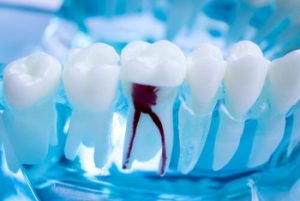A root canal—just the mention of it might make you uneasy. What if we told you that this dental procedure is designed to alleviate pain rather than cause it? And what is a root canal treatment? It is an excellent method for preserving a natural tooth and stopping the infection from spreading, reducing the need for extraction.
In this comprehensive guide, we’ll walk you through everything you need to know about root canal therapy—from why it’s necessary to what happens during the root canal process, the root canal cost, and how to prevent needing one in the future.
Why Would You Need a Root Canal?
A root canal becomes mandatory when the tooth pulp—the soft tissue inside your tooth containing blood vessels, nerves, and connective tissue—becomes infected or inflamed. Multiple factors can cause this, and if not treated promptly, the infection may spread, leading to intense pain, swelling, and potential tooth loss.
Common Causes of Root Canal Infections
A root canal treatment is typically required due to:
- Deep Tooth Decay

- When tooth decay progresses beyond the enamel and dentin, it can reach the pulp chamber, leading to an infected pulp.
- The bacteria from decay can cause inflammation and pain, requiring a root canal procedure to remove the infection.
- Repeated Dental Procedures on the Same Tooth
- A compromised tooth that has undergone multiple fillings, crowns, or restorations may develop irritation or infection in the root canal system.
- Repeated dental procedures weaken the tooth structure, making it more susceptible to bacterial invasion.
- Cracks or Fractures in the Tooth
- A crack in a natural tooth can allow bacteria to enter the tooth root, leading to infection.
- Even small, invisible cracks can expose the pulp chamber to bacteria, causing inflammation and pain.
- Trauma or Injury to the Tooth
- An injury to the mouth can damage the soft tissue inside the tooth, even if there are no visible cracks or chips.
- This can result in an infected tooth pulp or inflamed pulp that needs endodontic treatment.
- Abscess Formation in the Surrounding Bone
- If a root canal infection remains untreated, it can spread to the surrounding bone, potentially causing an abscess to develop.
- This leads to swelling, pain, and potential loss of the diseased tooth and nearby adjacent teeth.
- Failed Previous Root Canal Treatment
- In some cases, a previously treated tooth may develop a new infection due to incomplete removal of bacteria or reinfection.
- This may require endodontic retreatment to fully clean and seal the root canal system.
Signs You Might Need a Root Canal
If you’re experiencing any of the following symptoms, you may need a root canal:
- Persistent pain—especially when chewing or applying pressure
- Prolonged sensitivity to hot or cold temperatures
- Swollen gums near the affected tooth
- A small, pimple-like bump on the gums may indicate an abscess or a possible infection.
- Tooth discolouration due to an infected tooth pulp
- A constant toothache that does not subside
If you notice these signs, it’s crucial to seek dental attention promptly. Delaying root canal therapy can lead to further complications, including the need for tooth extraction and tooth replacement options.
The Root Canal Procedure: Step by Step
A root canal procedure is a comprehensive dental treatment that eliminates infection from the tooth pulp, thoroughly cleans the root canal system, and seals the affected tooth to prevent future infections.
While the idea of a root canal might seem intimidating, modern endodontic therapy is relatively straightforward, and most patients experience little to no discomfort during the procedure. Here’s what happens at each stage.
Step 1: Diagnosis and Examination:
Before beginning the root canal process, your dentist will:
- Assess your symptoms (such as tooth hurts, swelling, or severe pain).
- Take X-rays to assess the extent of infection or damage.
- Confirm whether a root canal is needed or if another treatment option is more suitable.
If a root canal infection is detected, the dentist will proceed with the treatment plan.
Step 2: Administering Local Anaesthesia:
- To ensure a comfortable experience, local anaesthesia is injected near the infected tooth.
- Once the area is numb, the procedure begins.
Despite common fears, modern root canal therapy is comfortable. In fact, it’s designed to alleviate pain, not cause it.
Step 3: Creating an Access Opening
- The dentist makes a small opening in the crown of the affected tooth to reach the pulp chamber.
- This allows access to the infected pulp, soft tissue, and blood vessels inside the tooth.
Step 4: Removing the Infected Pulp and Cleaning the Root Canal
- Using specialised instruments, the infected tooth pulp and inflamed pulp are removed.
- The infected material and bacteria inside the root canal system are eliminated.
- The canals are flushed with an antibacterial solution to disinfect the area and prevent reinfection.
This is a crucial step to ensure the root canal remains free of bacteria.
Step 5: Shaping and Filling the Root Canal
- The tooth root canals are shaped and cleaned further to prepare for the filling.
- A root canal-filling material called gutta-percha is inserted to seal the space.
- This prevents bacteria from re-entering and causing reinfection.
The gutta-percha acts as a protective barrier, keeping the root canal system sealed.
Step 6: Sealing the Tooth with a Temporary Filling
- After the gutta-percha is placed, a temporary filling is applied to close the opening in the tooth.
- This protects the treated tooth while it heals.
In some cases, if the infected root canal is severe, the dentist may place medication inside the canal and wait a few days before completing the process.
Step 7: Restoring the Tooth with a Crown or Filling
- A few weeks later, a permanent filling or crown is placed over the restored tooth.
- A crown is often recommended for molars and premolars to restore strength, as root canal therapy can weaken the tooth structure.
This final step ensures the treated tooth functions normally and blends with the other teeth.
What Happens After a Root Canal?
Following a root canal procedure, you might notice:
- Mild discomfort or tenderness, which should subside in a few days.
- Temporary sensitivity when chewing, especially if a temporary filling is used.
- A need for further treatment, such as a crown, to fully protect the tooth.
Once the final restoration is complete, the treated tooth can endure a lifetime with proper care.
How Long Does a Root Canal Take?
 The duration of a root canal procedure varies based on the tooth’s complexity and the extent of the infection. On average, the treatment takes 60 to 90 minutes per session.
The duration of a root canal procedure varies based on the tooth’s complexity and the extent of the infection. On average, the treatment takes 60 to 90 minutes per session.
- Single-rooted teeth (front teeth) usually require one appointment.
- Multi-rooted teeth (molars and premolars) may take two or more visits to ensure thorough cleaning and sealing.
- If the infection is severe, additional time may be needed for medication placement before completing the procedure.
Your dentist will determine the number of visits required based on your specific case.
Is a Root Canal Permanent?
With good care, a root canal-treated tooth can endure a lifetime. However, it’s essential to:
- Maintain good oral hygiene to prevent future infections.
- Schedule regular dental check-ups to monitor the restored tooth.
- Avoid biting hard objects if a crown is placed.
In rare cases, endodontic retreatment may be needed if reinfection occurs.
How Long Does It Take to Recover from a Root Canal?
Healing after a root canal treatment is generally swift. Here’s what you can anticipate:
- First 24-48 hours: Some tenderness around the treated tooth and gums, which subsides within a few days.
- One week later: Most discomfort should be gone, but avoid chewing on the same tooth until the final crown is placed.
- After a full restoration, Your tooth should function normally, just like any other natural tooth.
How Much Does a Root Canal Cost?
The cost of a root canal procedure in Australia typically starts at 800 AUD but can vary depending on several factors, including:
- Extent of infection: More severe cases may require additional treatment.
- Tooth location: Front teeth are generally less expensive to treat than molars due to their simpler structure.
- Additional dental work: A crown or filling may be needed to restore the treated tooth.
In most cases, a root canal is a more cost-effective option than extracting the tooth and replacing it with an implant or bridge.
What If You Ignore Root Canal Treatment?
If an untreated infected or damaged pulp is not addressed, the infection may spread, resulting in:
- Severe pain that worsens over time
- Swelling and abscess formation in the surrounding bone
- Tooth loss requiring more extensive tooth replacement options
- Infection spreads to other areas, potentially affecting overall health
Root canal therapy helps save your natural tooth and limits the need for more invasive treatments in the future.
How to Avoid a Root Canal in the Future
Although root canal therapy is a reliable solution for preserving a natural tooth, prevention is always the preferred approach. A root canal procedure is typically required when the tooth pulp is inflamed or infected due to tooth decay, trauma, or multiple dental procedures. By maintaining proper oral hygiene and taking proactive steps, you can safeguard your teeth and minimise the risk of developing an infected root canal.
Here are some essential steps to help you avoid root canal treatment in the future.
1. Maintain Good Oral Hygiene
Practising good oral hygiene is the most effective way to prevent tooth decay and infections that can lead to a root canal infection.
How to Keep Your Teeth Healthy:
- Brush twice daily using fluoride toothpaste to remove plaque and bacteria.
- Floss once a day to clean between teeth where a toothbrush can’t reach.
- Use an antibacterial mouthwash to kill harmful bacteria and reduce plaque buildup.
- Change your toothbrush every three months or earlier if the bristles become frayed or worn.
Maintaining good oral hygiene helps prevent deep decay, lowering the risk of damage to the tooth pulp and the need for endodontic treatment.
2. Visit Your Dentist Regularly
Routine dental visits and professional cleanings allow for early detection of tooth decay, infected tooth pulp, or gum disease before they become more severe issues.
Why Dental Visits Matter:
- Early detection of cavities prevents tooth decay from reaching the pulp chamber.
- Professional cleanings remove plaque and tartar, minimising the risk of infection.
- Routine X-rays help identify problems in the tooth root or root canal system before they cause severe pain.
Seeing a general dentist at least twice a year can prevent the need for root canal therapy and ensure long-term oral health.
3. Address Cavities and Dental Problems Early
Ignoring a minor cavity can allow decay to reach the tooth pulp, leading to an infected or damaged pulp that may require root canal treatment.
How to Prevent Decay from Worsening:
- Get small cavities filled promptly to prevent deeper infections.
- Repair cracked or chipped teeth before bacteria enter the root canal system.
- Treat gum disease early to avoid bacteria spreading to the tooth’s root.
Catching problems early can help you avoid more invasive dental procedures.
4. Protect Your Teeth from Injury
Trauma to the teeth can cause cracks, fractures, or damage to the blood vessels inside the tooth, leading to an infected root canal.
Ways to Prevent Tooth Damage:
- Use a mouthguard during contact sports to safeguard your teeth from potential injuries.
- Refrain from chewing on hard objects such as ice, pens, or fingernails to prevent tooth damage.
- If you grind your teeth (bruxism), wear a nightguard to prevent fractures.
By protecting your teeth from trauma, you reduce the risk of needing root canal therapy.
5. Avoid Excess Sugar and Acidic Foods
A diet rich in sugar and acidic foods boosts the risk of tooth decay, which may eventually lead to a root canal infection.
Tooth-Friendly Diet Tips:
- Limit sugary foods and drinks like sweets, soft drinks, and fruit juices.
- Choose calcium-rich foods like dairy, almonds, and leafy greens to strengthen enamel.
- Stay hydrated by drinking plenty of water to help rinse away bacteria and food particles.
- Avoid frequent snacking to reduce the risk of plaque buildup.
A healthy diet not only protects your teeth but also promotes overall oral health.
6. Be Cautious with Repeated Dental Procedures
Every time a compromised tooth undergoes a new dental treatment, its structure weakens, increasing the chances of needing a root canal procedure.
How to Reduce the Need for Repeated Dental Work:
- Choose long-lasting restorations to avoid multiple fillings on the same tooth.
- Opt for minimally invasive treatments when possible.
- Follow your dentist’s aftercare advice to prevent damage to restored teeth.
Minimising unnecessary dental procedures helps preserve your natural tooth for longer.
7. Treat Tooth Sensitivity Promptly
If your tooth hurts or becomes sensitive to hot, cold, or pressure, it could be an early sign of a tooth pulp infection. Addressing sensitivity early can prevent the need for a root canal process.
What to Do If You Have Sensitivity:
- Use a desensitising toothpaste to strengthen enamel.
- Avoid extremely hot or cold foods that trigger pain.
- Schedule a dental check-up to rule out deep cavities or cracks.
Ignoring sensitivity can allow infected material to spread, requiring more extensive treatment.
8. Strengthen Your Tooth Enamel
Weak enamel makes your teeth more susceptible to decay and infection, increasing the likelihood of needing a root canal procedure.
Ways to Strengthen Enamel:
- Use fluoride toothpaste and mouthwash to remineralise teeth.
- Limit acidic foods that erode enamel.
- Get professional fluoride treatments if recommended by your dentist.
Stronger enamel protects the tooth structure and reduces the risk of tooth pulp infection.
9. Watch for Early Signs of Infection
If you experience ongoing pain, swelling, or sensitivity, it’s important to see a dentist as soon as possible. Acting early can help prevent the need for a root canal and protect the affected tooth.
Frequently Asked Questions
- How do I know if I need a root canal?
If you experience persistent tooth pain, prolonged sensitivity to hot or cold, swollen gums, or a pimple-like bump near the affected tooth, you may need a root canal. A dentist can confirm this with an examination and X-rays. - How long does a root canal take?
A root canal generally takes one to two visits, with each session lasting between 60 and 90 minutes. The complexity of the tooth and the severity of the infection determine the total treatment time. - Can a root canal fail?
While root canal therapy is generally successful, reinfection may occur if the tooth is not adequately sealed or if a new cavity forms. In such instances, endodontic retreatment might be required. - What happens if I don’t get a root canal?
If an infected tooth is left untreated, it can result in severe pain, abscess formation, and potential tooth loss. Additionally, the infection may spread to the surrounding tissue and bone, leading to more serious health complications. - Can I eat after a root canal?
You should wait until the numbness wears off before eating. Soft foods are recommended for the first few days, and you should avoid chewing on the treated tooth until a permanent restoration is placed. - Do I need a crown after a root canal?
In most cases, a crown is necessary for molars and premolars to restore strength and function. Front teeth may only require a filling if enough tooth structure remains.
- Is a root canal more expensive than tooth extraction?
A root canal is often more cost-effective than extraction, followed by a replacement option like a dental implant or bridge. Saving a natural tooth also prevents additional complications. - How long does a root canal-treated tooth last?
With good care, a root canal-treated tooth can endure a lifetime. Good oral hygiene, regular dental check-ups, and avoiding excessive pressure on the tooth help ensure longevity. - Can I brush and floss normally after a root canal?
Yes, you should continue brushing and flossing as usual. However, be gentle around the treated tooth until it is fully restored with a permanent filling or crown. - Will my tooth feel different after a root canal?
The treated tooth may feel slightly different due to the removal of the nerve, but once fully restored, it should function just like your other natural teeth.
Final Thoughts: Root Canal Therapy Can Save Your Tooth
A root canal treatment may sound intimidating, but it is a routine, pain-relieving dental procedure that can save your compromised tooth and protect your oral health.
If you’re experiencing severe pain, sensitivity, or signs of an infected root canal, don’t wait—seek professional care. Early intervention can prevent further complications, allowing you to preserve your natural tooth for years to come. Contact Beyond Infinity Dental at (02) 8806 3799 to schedule your appointment today.
Note: Any surgical or invasive procedure carries risks. Before proceeding, you should seek a second opinion from an appropriately qualified health practitioner.
References
- Healthline. (n.d.). Tooth extraction. https://www.healthline.com/health/tooth-extraction
- Colgate. (n.d.). What is a pulp chamber? https://www.colgate.com/en-us/oral-health/mouth-and-teeth-anatomy/what-is-a-pulp-chamber
- Medical News Today. (n.d.). Root canal treatment: Everything you need to know. https://www.medicalnewstoday.com/articles/142780
- Mayo Clinic. (n.d.). Tooth abscess: Symptoms & causes. https://www.mayoclinic.org/diseases-conditions/tooth-abscess/symptoms-causes/syc-20350901
- Cleveland Clinic. (n.d.). Oral hygiene. https://my.clevelandclinic.org/health/treatments/16914-oral-hygiene
- WebMD. (n.d.). Dental X-rays. https://www.webmd.com/oral-health/dental-x-rays









